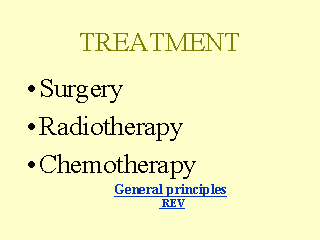|
|
|
|
front |1 |2 |3 |4 |5 |6 |7 |8 |9 |10 |11 |12 |13 |14 |15 |16 |17 |18 |19 |20 |21 |22 |23 |24 |25 |26 |27 |28 |29 |30 |31 |review |
 |
In treating cancer it is assumed that all malignant cells should be destroyed, removed or neutralized to achieve cure, since experimentally tumor control requires eradication of the last neoplastic cell. At present it is not known whether successful treatment must eradicate all neoplastic cells or merely reduce the cell number to a level that the hostís own defenses can control.
Three modalities of therapy exist today: surgery, radiotherapy and chemotherapy (including hormonal treatment). Immunotherapy has experienced a resurgence of interest since the 1980ís within the broader context of biological therapies (biologic response modifiers). Because cancer is not one but 100 or more different diseases, many therapeutic strategies using these three modalities alone or in combinations are used. Each patient requires a proper histological diagnosis of cancer with biochemical and immunological subtyping as appropriate, as well as proper staging of the extent of the disease. For solid tumors surgery and radiotherapy are used first to deal with early local and regional presentation of the disease. With dissemination, a systemic therapy such as chemotherapy or hormonal therapy is used for for palliation. Hematological malignancies may be disseminated from the start, so that chemotherapy is used initially. In breast and colorectal cancers chemotherapy may also be used as an adjuvant to local therapy to reduce recurrences and prolong survival. Neoadjuvant therapy uses chemotherapy before surgery to allow for more conservative local therapy. |